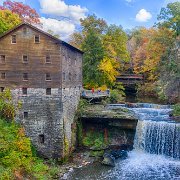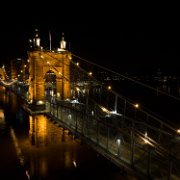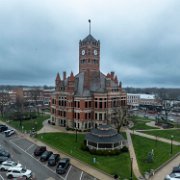
2 Lanterman's Mill Lanterman's Mill is a historic landmark located in Youngstown, Ohio, USA. Built in the mid-1800s, the mill was originally used for grinding grains into flour and cornmeal. It was later converted into a hydroelectric power plant before being restored and turned into a museum. Today, visitors can explore the mill and learn about its history, as well as enjoy the surrounding park and hiking trails. Lanterman's Mill is a popular destination for both tourists and locals alike, and is a testament to the region's rich industrial and agricultural heritage.

3 Lanterman's Mill Lanterman's Mill is a historic landmark located in Youngstown, Ohio, USA. Built in the mid-1800s, the mill was originally used for grinding grains into flour and cornmeal. It was later converted into a hydroelectric power plant before being restored and turned into a museum. Today, visitors can explore the mill and learn about its history, as well as enjoy the surrounding park and hiking trails. Lanterman's Mill is a popular destination for both tourists and locals alike, and is a testament to the region's rich industrial and agricultural heritage.

4 The John A. Roebling Suspension Bridge, originally known as the Cincinnati-Covington Bridge, spans the Ohio River between Cincinnati, Ohio, and Covington, Kentucky. When opened on December 1, 1866, it was the longest suspension bridge in the world at 1,057 feet (322 m) main span, which was later overtaken by John A. Roebling's most famous design of the 1883 Brooklyn Bridge at 1,595.5 feet (486.3 m). Pedestrians use the bridge to get between the hotels, bars, restaurants, and parking lots in Northern Kentucky. The bar and restaurant district at the foot of the bridge on the Kentucky side is known as Roebling Point.
Ramps were constructed leading directly from the bridge to the Dixie Terminal building used for streetcars. These provided Covington–Cincinnati streetcars "with a grade-separated route to the center of downtown, and the terminal building was originally intended to connect, via underground pedestrian passages, with the never-built Fountain Square Station of the infamous Cincinnati Subway." When streetcar service ceased in the 1950s, the terminal was converted to a diesel bus terminal. The ramps were removed in 1998 when it ceased being used as a bus terminal
Ramps were constructed leading directly from the bridge to the Dixie Terminal building used for streetcars. These provided Covington–Cincinnati streetcars "with a grade-separated route to the center of downtown, and the terminal building was originally intended to connect, via underground pedestrian passages, with the never-built Fountain Square Station of the infamous Cincinnati Subway." When streetcar service ceased in the 1950s, the terminal was converted to a diesel bus terminal. The ramps were removed in 1998 when it ceased being used as a bus terminal

5 The John A. Roebling Suspension Bridge, originally known as the Cincinnati-Covington Bridge, spans the Ohio River between Cincinnati, Ohio, and Covington, Kentucky. When opened on December 1, 1866, it was the longest suspension bridge in the world at 1,057 feet (322 m) main span, which was later overtaken by John A. Roebling's most famous design of the 1883 Brooklyn Bridge at 1,595.5 feet (486.3 m). Pedestrians use the bridge to get between the hotels, bars, restaurants, and parking lots in Northern Kentucky. The bar and restaurant district at the foot of the bridge on the Kentucky side is known as Roebling Point.
Ramps were constructed leading directly from the bridge to the Dixie Terminal building used for streetcars. These provided Covington–Cincinnati streetcars "with a grade-separated route to the center of downtown, and the terminal building was originally intended to connect, via underground pedestrian passages, with the never-built Fountain Square Station of the infamous Cincinnati Subway." When streetcar service ceased in the 1950s, the terminal was converted to a diesel bus terminal. The ramps were removed in 1998 when it ceased being used as a bus terminal
Ramps were constructed leading directly from the bridge to the Dixie Terminal building used for streetcars. These provided Covington–Cincinnati streetcars "with a grade-separated route to the center of downtown, and the terminal building was originally intended to connect, via underground pedestrian passages, with the never-built Fountain Square Station of the infamous Cincinnati Subway." When streetcar service ceased in the 1950s, the terminal was converted to a diesel bus terminal. The ramps were removed in 1998 when it ceased being used as a bus terminal

6 The John A. Roebling Suspension Bridge, originally known as the Cincinnati-Covington Bridge, spans the Ohio River between Cincinnati, Ohio, and Covington, Kentucky. When opened on December 1, 1866, it was the longest suspension bridge in the world at 1,057 feet (322 m) main span, which was later overtaken by John A. Roebling's most famous design of the 1883 Brooklyn Bridge at 1,595.5 feet (486.3 m). Pedestrians use the bridge to get between the hotels, bars, restaurants, and parking lots in Northern Kentucky. The bar and restaurant district at the foot of the bridge on the Kentucky side is known as Roebling Point.
Ramps were constructed leading directly from the bridge to the Dixie Terminal building used for streetcars. These provided Covington–Cincinnati streetcars "with a grade-separated route to the center of downtown, and the terminal building was originally intended to connect, via underground pedestrian passages, with the never-built Fountain Square Station of the infamous Cincinnati Subway." When streetcar service ceased in the 1950s, the terminal was converted to a diesel bus terminal. The ramps were removed in 1998 when it ceased being used as a bus terminal
Ramps were constructed leading directly from the bridge to the Dixie Terminal building used for streetcars. These provided Covington–Cincinnati streetcars "with a grade-separated route to the center of downtown, and the terminal building was originally intended to connect, via underground pedestrian passages, with the never-built Fountain Square Station of the infamous Cincinnati Subway." When streetcar service ceased in the 1950s, the terminal was converted to a diesel bus terminal. The ramps were removed in 1998 when it ceased being used as a bus terminal

7 Williams County Courthouse, at the intersection of Main and High Streets in Bryan, is the county courthouse serving Williams County, Ohio. The courthouse was built in the late nineteenth century to replace an earlier courthouse; Bryan had been the Williams County seat since 1840. Architect E.O. Fallis of Toledo designed the courthouse in the Romanesque Revival style, which was nationally popular in the late nineteenth century. The design for the courthouse was approved by the county in 1888, and the building's cornerstone was placed the next year; construction was completed in 1891. The courthouse features a large clock tower at its center and eight turrets on its sides, with a large and a small turret atop each entrance bay.[2]
The courthouse was added to the National Register of Historic Places on May 7, 1973
The courthouse was added to the National Register of Historic Places on May 7, 1973

Ohio